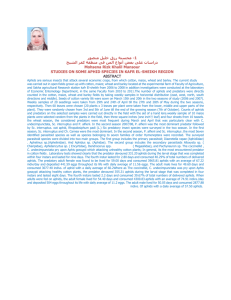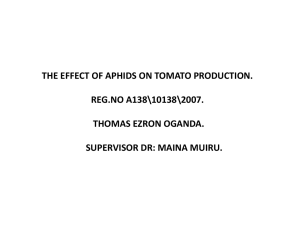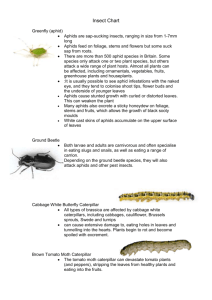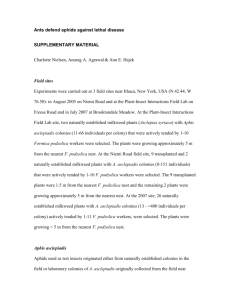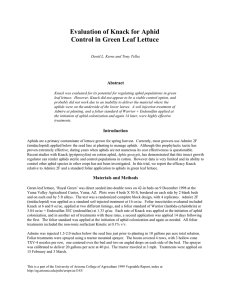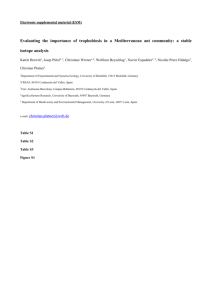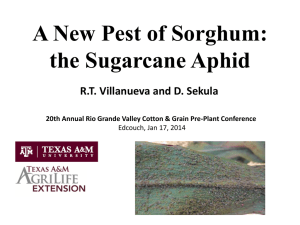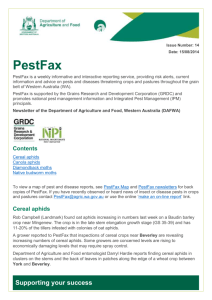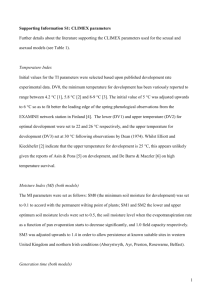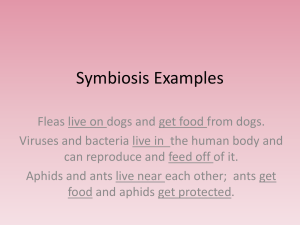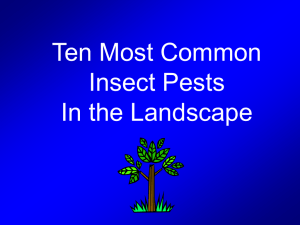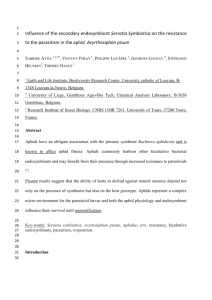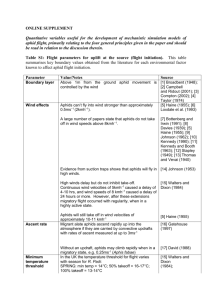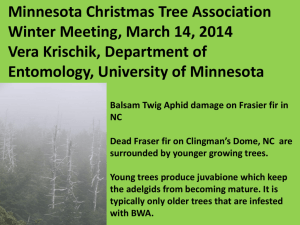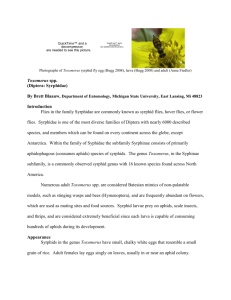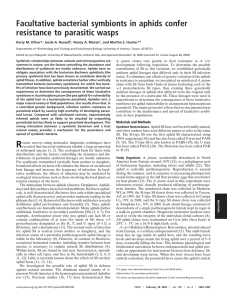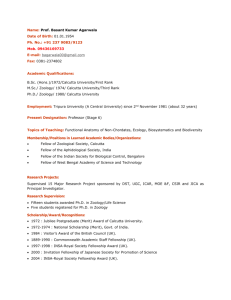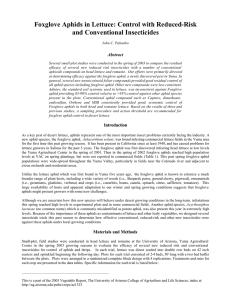Avoiding Autotoxicity - New York Biology Teachers` Association
advertisement
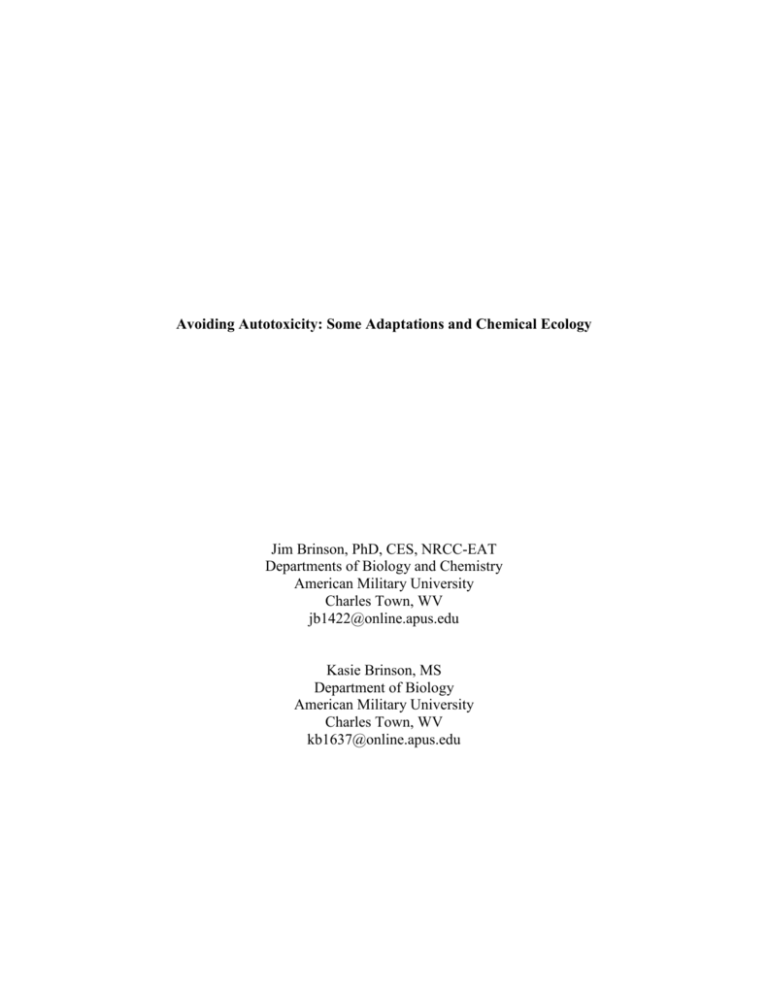
Avoiding Autotoxicity: Some Adaptations and Chemical Ecology Jim Brinson, PhD, CES, NRCC-EAT Departments of Biology and Chemistry American Military University Charles Town, WV jb1422@online.apus.edu Kasie Brinson, MS Department of Biology American Military University Charles Town, WV kb1637@online.apus.edu Avoiding Autotoxicity: Some Adaptations and Chemical Ecology The use of chemicals to ward off attack by a predator or to prevent encroachment on habitat or resources is common throughout the plant and animal kingdoms. For some animals a chemical defense system would be a bad investment because it is not needed. A lion is in little danger because it has no natural enemies and the gazelle relies on its natural speed and agility to avoid predators. Thus, large vertebrates are exceptional, utilizing strength and size to maintain their position at the top of the food chain. At the other extreme are the many insects that have little mobility and are physically unable to defend themselves, and plants that, in the absence of a defensive mechanism, would be eliminated by foraging animals, other insects, etc. There are numerous examples of chemical defense that range from the skunk that wards off predators with a noxious spray containing thiols, to the poisonous reptiles like rattlesnakes that defend themselves with venomous bites. Chemical defense agents are rarely the same materials that are utilized by the organism for critical life processes such as photosynthesis, respiration, metabolism or digestion. Rather, the predominant source of chemical defense agents is from metabolites of physiologically important molecules, thus leading to the label, "secondary metabolites." For example, amino acids are the source of the alkaloids and cardiac glycosides often used as defensive agents. It is noteworthy that, although primary metabolites are virtually universally distributed in cells and organs, secondary metabolites are often idiosyncratic taxonomically. For example, whereas chlorophyll is found in all developmental stages of virtually all angiosperms, secondary metabolites vary among members of a species, among body parts in any particular stage of development and there is variation during different stages of development. The very fact that these secondary metabolites are toxic or noxious to the predators of any organism suggests that they might also have the same effect on the organism. As a result, chemical defenses often utilize specialized synthesis and storage strategies. Compartmentalization of these materials is common and external storage and delivery systems are often utilized even when the active agent is obtained from an external source. The external delivery systems are a clever strategy for avoiding autotoxicity during periods of safety and minimizing danger while defending during attack from a predator So, generally speaking, even if it is not via compartmentalization, animals with chemical defensive strategies generally have a mechanism or mechanisms by which they protect themselves from their own toxic chemicals. Aphids, scorpions, and sea slugs are just a few examples of animals that employ “self-immunity” to their toxins, with the latter two employing mechanisms not related to compartmentalization. Compartmentalization involves sequestering toxic secondary metabolites, and externally storing and delivering them. Such is the case with the millipede Apheloria, which stores a precursor to hydrogen cyanide (HCN) in one membranous gland in its segments, and an enzyme (structure unknown) in an adjacent vestibular gland. When the contents are mixed, HCN is produced and released through an external cuticle-covered structure that is protected from the toxic gas. Similarly, the Bombardier Beetle also compartmentalizes via gland pairs in its abdomen, one for hydrogen peroxide and hydroquinone and one for catalase and peroxidase enzymes, that when mixed, create a hot, pressurized mixture of benziquinone. Since this takes place outside of the cuticular shell, the beetle is protected. In a similar fashion, Sea Slugs also protect themselves from their own chemical defenses via glandular compartmentalization. When threatened, the Sea Slug dishcharges and inky solution of ammonia, hydrogen peroxide, and various acids. In a research study led by Dr. Charles Durby (2007) of Georgia State University, ink and opaline glands of the sea slug Aplysia californica were examined. In his previous research, Durby found that an enzyme termed escapin controls a chemical reaction between L-lysine and Larginine to produce the aforementioned products. His team was able to pinpoint which chemicals were coming from which glands, discovering that L-lysine and L-arginine Aplysia (Aplysia californica) sea slug. Photo courtesy of Columbia University, New York. were housed in the opaline gland (the gland primarily responsible for the sticky texture and whitish color of the mixture), while escapin was kept in the ink gland (the gland responsible for the purple dye of the mixture). Aplysia thus packages these precursors separately, then releases them simultaneously into its mantle cavity. Interestingly, this secretion seems to suppress feeding behaviors in most animals, but not spiny lobsters. The implications of this stimulation are still largely unstudied. Also, it seems that the reaction of escapin and L-lysine yields a product with anti-microbial properties, and Derby’s research team plans on exploring this specific chemical process further, as well as the animals that are affected by this specific property of the secretion. The aphid is yet another example of an animal that can avoid autotoxicity. It too relies on chemical precursor separation, but in a slightly different method than discussed above. The chemical reaction that occurs when a cabbage aphid, for example, is attacked results in a chemical “bomb” that kills the aphid, but protects the colony. Throughout its life, the aphid is able to keep the ingredients for the bomb separated so as to remain immune from the effects of the reaction until tissue damage from a predator attack causes them to mix. What is interesting here is that normally such a defense against autotoxicity usually results in self-preservation after employing the defense mechanism. In this case, however, when the mechanism is triggered, the aphid commits controlled suicide for the sake of the colony. Feeding aphids. Photo courtesy of www.earthlife.net. Aphids feed on a variety of plants, and plants utilize many different chemicals to protect themselves from predators. Cruciferous vegetables like mustard, watercress, and wasabi, rely on glucosinolates as an example, and these chemicals can be ingested and stored by aphids for their own defensive use. When glucosinolates are catalytically converted by the enzyme myrosinase, the result is a violent reaction that releases several toxins, mainly allyl isothiocyanate (the main flavoring agent of mustard and horseradish). The plant stores the ingredients separately, and when an animal attempts to eat it, the tissue is damaged, allowing barriers of separation to be broken and the reactants now combine to trigger the release of toxins like allyl isothiocyanate. Though cabbage aphids do not neutralize this chemistry, such as through the proteins produced by certain caterpillars that inactivate glucosinolates, they are capable of gradually accumulating the glucosinolates within their own tissues. How mustard’s (Sinapis alba) primary glucosinolate produces thiocyanate. Courtesy of M.J. Mora, College of Agricultural and Life Sciences, University of Idaho (http://soils.cals.uidaho.edu). Researchers from Imperial College London have shown that Aphids have their own version of the myrosinase enzyme that they store in the muscle tissue of their head and thorax (Kazana et al., 2007). It appears that small amounts of the enzyme is maternally transferred to embryos, but it must be accumulated throughout life. The glucosinolates found in aphids, however, completely come from plants. Upon ingestion, the glucosinolates end up and remain circulating in aphid blood, and they are not ultimately stored in any sort of anatomically separate special membranous gland. Thus, they are kept separate from the myrosinase that is kept in the muscle tissue. And rather than having a control mechanism to self-trigger the response, the reactants only mix when the blood and muscle to mix, such as with a predator bite, thus leaving the aphid with no post-event protection, only pre-event protection. myrosinase MA1 allyl isothiocyanate It seems that efficiency trumps all when it comes to the defense mechanisms that organisms possess. The processes involved with chemical defense mechanisms come with great energetic cost to the organism, so if an animal already has a sufficient means of predator avoidance, chemical defenses are unnecessary. A great example of this is found in aphids, which exist in both winged and non-winged form. Winged aphids were found to secrete the glucosinolates they consumed rather than storing them, so they were nowhere near as toxic as their non-winged counterparts. It seems that being able to fly is a sufficient means of avoiding predation in this case. One question that comes to mind when considering this “exploding bomb” mechanism is by what means it could be genetically conserved in the population, given that aphids die upon enacting this mechanism, and could presumably do so at a quick enough rate to see a decline in the manifestation of this defense in the general population. However, aphids mostly reproduce asexually, so a colony is often times made of aphid clones, which ensures conservation of the genes necessary for control of this chemical defense. A third example of how animals protect themselves from their own toxins can be found with the scorpion. The puffer fish releases tetrodotoxin, which blocks sodium ion channels. Similarly, scorpion venom consists of a group of polypeptides, the short chains Photo courtesy of www.gawker.com. of which are capable of blocking potassium ion channels (specifically channels known as Kv1.3 channels that help control T-cell proliferation, which leads researchers to believe that the toxin may help serve as a potential medical immunosuppressant) (Yu et al., 2004). However, longer chain toxins also are responsible for blocking sodium and chloride channels as well. Crystal structure of long-chain toxin II from the scorpion Androctonus australis Hector Chlorotoxin is a 36-amino acid peptide found in the venom of the deathstalker scorpion (Leiurus quinquestriatus) which blocks small-conductance chloride channels. Research suggests that scorpion toxin is comprised of around 66 amino acid residues and is cross-linked by 4 disulfide bridges (Rochat & Gregoire, 1983). Whereas in puffer fish there seemed to be a genetic mutation that left the fish immune to the effects of the tetrodotoxin they produced, research has yet to suggest a similar mutation in the scorpion to yield a different amino acid sequence that comprise their ion channels. Instead, it seems scorpions may possess in their blood a soluble antitoxin, perhaps in the form of high-affinity IgG and IgA antibodies that neutralize the venom, likely by changing the folding pattern of the polypeptide chains (Menez & Vita, 1999). However, this research is not conclusive. Fortunately, of the 30 or so native species of scorpions in the United States, only the Arizona bark scorpion has proven lethal to humans. Literature Cited Derby, C.D. (2007). Escape by inking and secreting: Marine molluscs avoid predators through a rich array of chemicals and mechanisms. Biological Bulletin 213: 274289. Kazana, E., T.W. Pope, L. Tribbles, M. Bridges, J.A. Pickett, A.M. Bones, G. Powell, and J.T. Rossiter. (2007). The cabbage aphid: A walking mustard oil bomb. Proceedings of the Royal Society B: Biological Sciences 274(1623): 2271-2277. Menez, A., and C. Vita. (1999). Engineering novel miniproteins out of toxins. 7th International Neurotoxicology Association Meeting: Leicester, United Kingdom. Rochat, H., and J. Gregoire. (1983). Covalent structure of toxins I and II from the scorpion Buthus occitanus tunetanus. Toxicon 21(1): 153–162. Yu, K., W. Fu, H. Liu, X. Luo., K. X. Chen, J. Ding, J. Shen, and H. Jiang (2004). Computational simulations of interactions of scorpion toxins with the voltagegated potassium ion channel. Biophysical Journal 86(6): 3542-3555.

